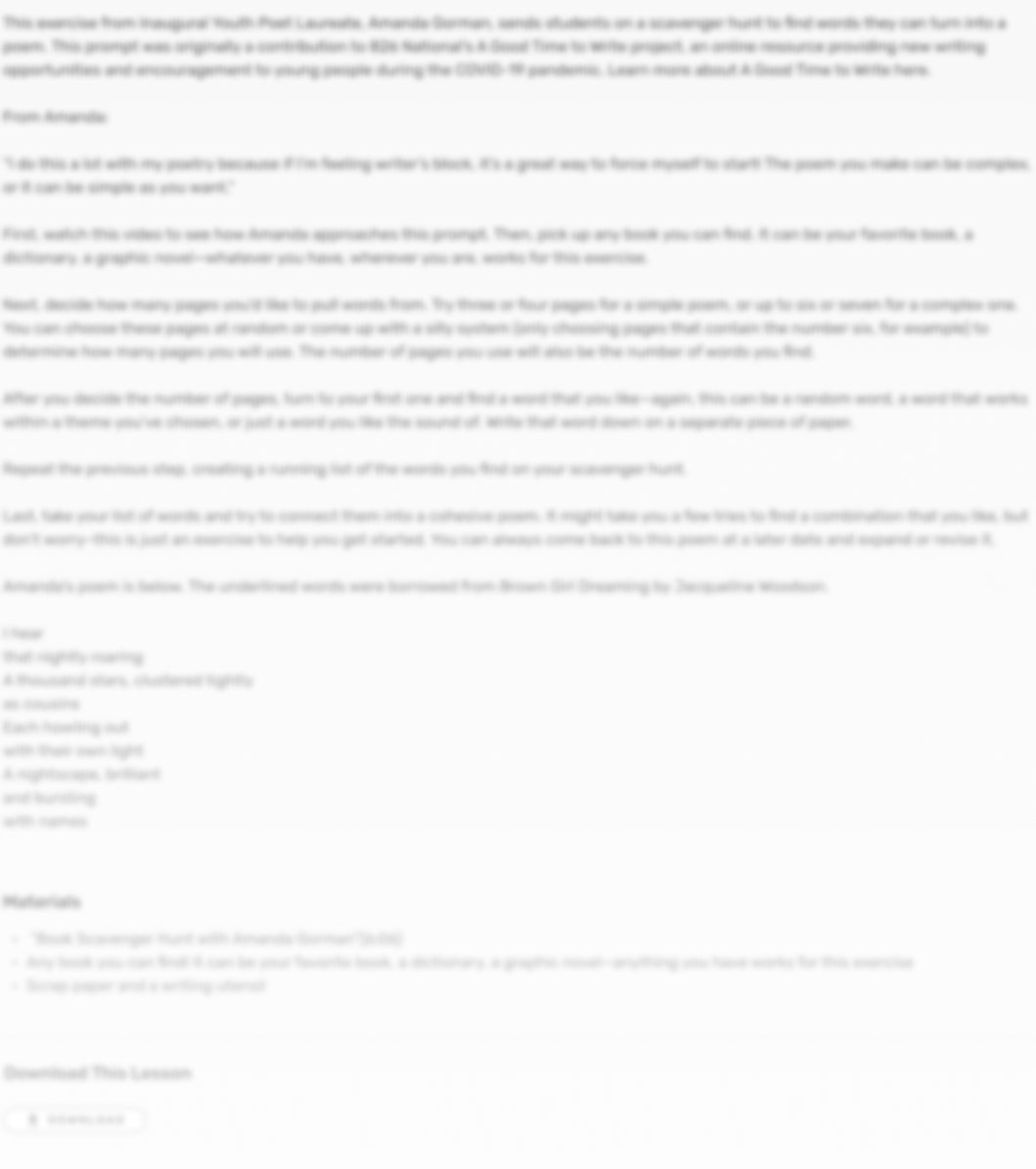 Grades 8–12
Grades 8–12 3 Sessions: 60-90 Minutes Each
3 Sessions: 60-90 Minutes Each Informational, Media, Poetry
Informational, Media, Poetry Lessons
LessonsStudents connect with members of the deceased buried in a local cemetery and imaginatively exhume a character by investigating their personal history and creatively representing the story of a life.










































by Ryan Harty, 826michigan
By examining patterns in engaging published stories and applying a set of meaningful prompts, students will learn how to develop well-rounded characters that readers really care about.
by Cristeta Boarini, 826 MSP
Students will identify something they have inherited from their families, conduct interviews, and write a narrative essay. This lesson is especially well suited for English Language Learners.
by Debra Mitchell, 826CHI
Students become script detectives in this lesson, searching for the underlying structure of every play. Student then draw from memories to inspire original plays.
by Jillian Wasick, 826 Valencia
Students write ekphrastic poems, exploring and creating connections between text and image.
by 826 New Orleans
In this lesson, students have an opportunity to write a letter expressing their views on issues that matter to them most surrounding an election.
by Ellen Lathrop and Malia Urbina, 826 Valencia
In this lesson, students will use descriptive language to write a poem about a favorite animal.
by Daniel José Older, author of Flood City.
Students will work together to produce a newspaper for the fictional Flood City. In the process, they will take on the roles of editor and journalist to source, draft, and present their newspaper.
by Ola Faleti, 826CHI, with an introduction by Amanda Gorman, Inaugural Youth Poet Laureate of the U.S.
The pen is mightier than the sword. In this lesson, students learn there's no better evidence of this than the poetry behind social movements.
by Stephanie Wykstra, 826NYC
A student’s guide for evaluating evidence and learning to spot misleading and false information.
by Kelly Jones, 826 New Orleans
Through writing, drawing, mapping, and researching a chosen fruit, students will become more familiar with the often complex history of food and how people access it.
by Aarti Monteiro, 826NYC
Students will read a poem by Eve L. Ewing and learn to write a poem that retells or reimagines an experience.
by Bryan Wilson, Educator Leader, The Bureau of Fearless Ideas
What do you get when you mix foraging with metaphors? Metaphoraging, of course! In this interactive lesson, students will forage their learning space for metaphors.
by Erin Ruane, 826 New Orleans
In this lesson, students are challenged to reevaluate the way water and land are represented on a map.
by Rebecca Darugar, Liz Levine, and Brancey Mora, 826NYC and 826 National
Invite students to write about their personal experiences with social media and online platforms with this lesson from 826NYC.
by Rebecca Darugar, 826NYC
Students examine relationships between art, poetry, politics, and current events, and reflect on personal experiences while writing social justice poetry.
by 826 National
What happens when we start from a place of gratitude? In this lesson, students will use Ross Gay’s "Catalog of Unabashed Gratitude" as a catalyst for a daily gratitude journal.
Inspired by Angela Iton and Precediha Dangerfield, 826 Valencia
In this lesson, students will use mentor texts to hone their revision skills before turning to their own poetry drafts.
by 826 National
Inspired by George Ella Lyon’s original poem, this lesson guides students through naming the people, places, and things that have shaped them.
by Julius Diaz Panoriñgan, 826LA
Students explore multiple STEM disciplines and the importance of scientific modeling, all in context of an upcoming zombie apocalypse. They'll write technical notes and create an ongoing narrative.
by Mallory Miller, 826 Digital Educator Leader
In this lesson, students will construct a short narrative told through concrete poems.
by Lisa Lutz, 826 Valencia
In this lesson by a young adult author and self-confessed superfan Lisa Lutz, students will learn letter-writing tips and create a fan letter.
by Katie Manning and Brandon Brown, 826LA
Students enter The Poetry Laboratory, no lab coats required, and use methods of observation and playful strategies to embark on the process of writing poetry.
by Rebecca Darugar, 826NYC
Students will work in a collaborative, constructive setting to create a vision for your classroom as a safe space for students and teachers.
by Alana Herron, 826 Digital Educator Leader
Students will craft an argument about a controversial topic they hold a personal connection to and record their argument to persuade their audience.
by Karla Brundage, 826 Valencia
In this Lesson, students will further their understanding of how language can impact identity through the process of naming.
by Saiya Miller, 826 New Orleans
Students will collect dirt, map their neighborhood, and listen to music that explores low sound, depth of soil, and the psychological landscape of New Orleans.
by Gem Carmella, Ministry of Stories and BBC History
In this Lesson, students will learn how to write comedy sketches inspired by "Monty Python’s Flying Circus."
by Naomi Solomon, 826NYC
In this lesson, students will learn about different types of rhymes, identify rhymes in lyrics and generate rhymes to use in their own lyrics.
by Cristeta Boarini, 826 MSP
In this lesson, students explore the genres of historical and speculative fiction before they reimagine a time they felt powerless and write a different outcome.
by Klariza Alvaran, 826CHI
In this lesson, students explore the graphic novel genre with a focus on plot and character development, scripting dialogue, and visual composition.
by Christopher Ankney, AT Bianchi, & Amy Wilson, 826michigan
Using Twitter as a storytelling medium, students will improve their understanding of perspective, editing for brevity, and the importance of word choice.
by Dave Eggers, 826 Valencia
Over a flexible series of activities, students will learn to draw details from real life to create unforgettable characters and compelling stories.
by Tim Campos, 826 New Orleans
Through discussion, map-making, and writing, students will investigate the ways in which our knowledge of places is constructed and will uncover the ways that this knowledge is distorted by biases.
by Mariama J. Lockington & Peter Calhoun Hall, 826NYC
In this superlesson, students isolate DNA, design planes, build lairs, and engineer safe transport to help a hero save the day. Students will also take technical notes and explore new forms of poetry.
by Allison Peters, 826michigan
Discover what’s possible through writing. In this lesson, students will write a thrilling new story about their future selves inspired by their curiosity and imagination.
by Catherine Calabro, with inspiration from Rachel Feder, 826michigan
Your students will use free writes, writing games, cheesy pop lyrics, and revision strategies to learn how to make connections between all of the points on their journey of writing a poem.
by Aarti Monteiro, 826NYC
Emotions play a big role in how we remember places important to us. Students explore this notion by writing memoirs, using plot, dialogue, and description to bring their stories to life.
by Kyley Pulphus, 826 New Orleans
In this workshop, students will create a pourquoi tale, or origin story, of how a local delicacy came to be.
by Cristeta Boarini, 826MSP, and Skylar Burkhardt, 826 National
Few expressions of gratitude are more meaningful than a personalized letter. In this lesson, students reach out to essential workers and return their acts of service and kindness by giving thanks.
by 826 National, in partnership with Paramount Pictures
Imaginary friends come in all shapes and sizes! Inspired by the new Paramount Pictures movie, IF, students will create their own imaginary friend to take with them on their next adventure.
by Laura Lisabeth, Ph.D, 826NYC
In this lesson, students experiment with the multimodal composition of Instagram and use this social media platform to promote a social justice issue.
by Louise McCune, 826 Valencia
Working as budding archaeologists, students use artifacts as inspiration for several short writing pieces.
by Tom Molanphy, 826 Valencia
Students will learn to see home in a fresh way, to walk through doors and open windows they never noticed, and to find the stories that home holds.
by Molly Sprayregen, 826CHI
Over the course of this lesson, students produce memoirs, poems, and essays that explore what it means to be a member of the LGBTQIA community in America today.
by Allie Mariano, 826 New Orleans
Students will tell stories about their neighborhoods and create maps that document change. The end result is a better understanding of a map’s ability to demonstrate the history behind fixed points.
by Ryan Harty, 826michigan
By examining patterns in engaging published stories and applying a set of meaningful prompts, students will learn how to develop well-rounded characters that readers really care about.
by Kyley Pulphus, 826 New Orleans
This lesson supports college-bound students in writing compelling personal statements. Students will go from blank page to finished draft as they brainstorm, develop, and analyze personal statements.
by Dr. Anne Desrosiers and Precediha Dangerfield, 826 Valencia
The COVID-19 pandemic changed our lives. This lesson will support students in processing the changes in their everyday lives and help them to identify the creativity their community has exhibited.
by Emily Clader & Daniel Reck, 826michigan
Students will create infinite poems using fractals, imagine life on a doughnut, and speculate about a universe where time goes crazy. Along the way, they'll explore cool, new math facts and concepts.
by Robert Paterno, 826LA
A mock crime scene kick-starts this lesson, getting students to hone their inferencing skills and serving as inspiration for crime stories.

